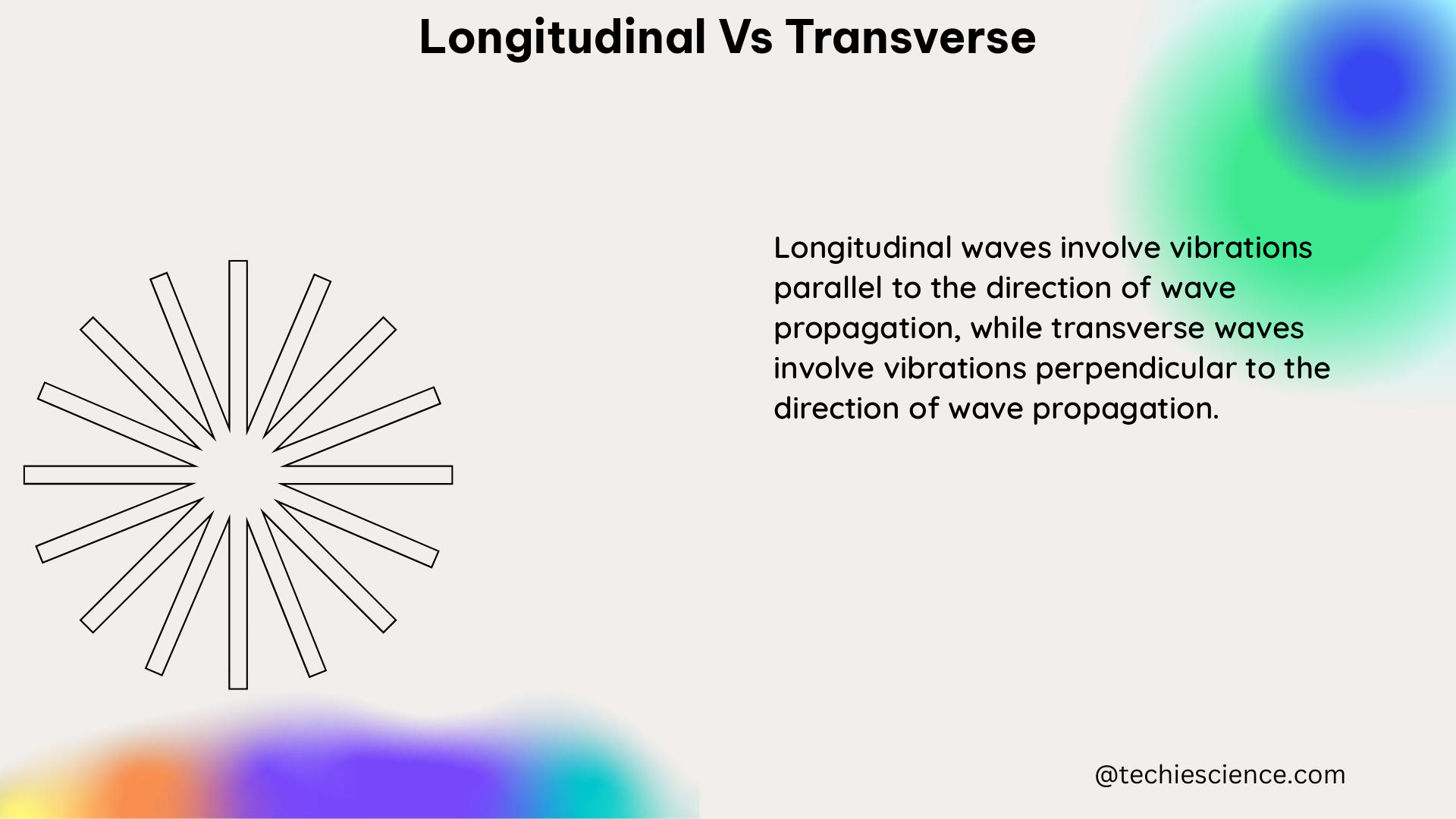Longitudinal and transverse waves are two fundamental types of waves that differ in the direction of their particle motion relative to the direction of wave propagation. Longitudinal waves, also known as compressional or longitudinal pressure waves, have particle motion in the same direction as wave propagation, while transverse waves have particle motion perpendicular to the direction of wave propagation.
Understanding the Differences: Particle Motion and Wave Propagation
To understand the difference between longitudinal and transverse waves, consider the example of a slinky. When you shake the slinky up and down, creating crests and troughs, you are creating transverse waves. However, if you shake the slinky back and forth, creating areas of higher density and lower density, you are creating longitudinal waves.
Mathematically, the particle displacement in a longitudinal wave can be represented as:
u(x,t) = A cos(kx - ωt)
where u(x,t) is the particle displacement, A is the amplitude, k is the wavenumber, x is the position, ω is the angular frequency, and t is the time.
In contrast, the particle displacement in a transverse wave can be represented as:
u(x,t) = A cos(kx - ωt)
v(x,t) = B sin(kx - ωt)
where u(x,t) and v(x,t) are the particle displacements in the x and y directions, respectively, and A and B are the amplitudes.
Quantifying the Differences: Attenuation Coefficients and Conductivity Components

In terms of measurable and quantifiable data, longitudinal and transverse waves have different properties that can be measured and compared. For instance, in the context of ultrasonic measurements, the attenuation coefficients of longitudinal and transverse bulk acoustic waves can be determined from measurements of the decay-rate of two independent zero-group-velocity resonances in a couple of matched plates.
In a study, the longitudinal and transverse attenuation of tungsten was found to be:
| Frequency | Longitudinal Attenuation | Transverse Attenuation |
|---|---|---|
| 2.16 GHz | 1918 m^-1 | 7828 m^-1 |
| 2.46 GHz | 3265 m^-1 | 12181 m^-1 |
Moreover, in the context of physics, the conductivity of a material can be separated into longitudinal and transverse components, which can be used to analyze experimental data obtained from reflectivity measurements. The real part of the longitudinal conductivity has a peak centered at ω = 0 and of width τ^-1, known as the “Drude peak”.
Practical Applications and Examples
Longitudinal and transverse waves have a wide range of practical applications in various fields, including:
- Seismology: Earthquakes generate both longitudinal (P-waves) and transverse (S-waves) waves, which can be used to study the Earth’s interior structure.
- Acoustics: Longitudinal waves are used in ultrasound imaging, while transverse waves are used in musical instruments and sound propagation.
- Optics: Transverse waves are used in the propagation of electromagnetic waves, such as light and radio waves.
- Material Science: The attenuation coefficients and conductivity components of longitudinal and transverse waves can be used to characterize the properties of materials.
For example, in the field of material science, the longitudinal and transverse attenuation coefficients can be used to determine the elastic properties of materials, such as the Young’s modulus and the shear modulus. These properties are crucial in the design and analysis of various engineering structures and components.
Numerical Examples and Problem-Solving
To further illustrate the differences between longitudinal and transverse waves, let’s consider a few numerical examples:
- Calculating Particle Displacement: Suppose a longitudinal wave has an amplitude of 2 mm, a wavenumber of 0.1 rad/m, and an angular frequency of 10 rad/s. Calculate the particle displacement at a position of 5 m and a time of 2 s.
Solution:
u(x,t) = A cos(kx - ωt)
u(5,2) = 2 cos(0.1 × 5 - 10 × 2)
u(5,2) = 2 cos(-5) = 2 × (-0.96) = -1.92 mm
- Determining Attenuation Coefficients: A material has a longitudinal attenuation coefficient of 2000 m^-1 and a transverse attenuation coefficient of 8000 m^-1 at a frequency of 2.3 GHz. Calculate the ratio of the transverse to longitudinal attenuation coefficients.
Solution:
Ratio of transverse to longitudinal attenuation coefficients = 8000 / 2000 = 4
- Analyzing Conductivity Components: A material has a longitudinal conductivity with a Drude peak centered at 1 GHz and a width of 0.1 GHz. Calculate the relaxation time (τ) of the material.
Solution:
Relaxation time (τ) = 1 / (2π × 0.1 GHz) = 1.59 ns
These examples demonstrate how the specific properties and characteristics of longitudinal and transverse waves can be quantified and used to analyze various physical systems and materials.
Conclusion
Longitudinal and transverse waves are two fundamental types of waves that differ in the direction of their particle motion relative to the direction of wave propagation. Understanding the differences between these two wave types, as well as their measurable and quantifiable properties, is crucial for physics students and researchers working in various fields, such as seismology, acoustics, optics, and material science.
By mastering the concepts and techniques presented in this comprehensive guide, you will be well-equipped to tackle complex problems and analyze the behavior of different materials and systems using the unique properties of longitudinal and transverse waves.
References
- https://www.reddit.com/r/Mcat/comments/18gtmbo/longitudinal_vs_transverse/
- https://young.physics.ucsc.edu/232/rpa2.pdf
- https://pubs.aip.org/asa/jasa/article-abstract/153/4/2090/2883303/Determining-longitudinal-and-transverse-elastic?redirectedFrom=fulltext
- https://www.physicsclassroom.com/class/waves/Lesson-3/Longitudinal-and-Transverse-Waves
- https://www.britannica.com/science/longitudinal-wave
- https://www.sciencedirect.com/topics/engineering/transverse-wave

The lambdageeks.com Core SME Team is a group of experienced subject matter experts from diverse scientific and technical fields including Physics, Chemistry, Technology,Electronics & Electrical Engineering, Automotive, Mechanical Engineering. Our team collaborates to create high-quality, well-researched articles on a wide range of science and technology topics for the lambdageeks.com website.
All Our Senior SME are having more than 7 Years of experience in the respective fields . They are either Working Industry Professionals or assocaited With different Universities. Refer Our Authors Page to get to know About our Core SMEs.